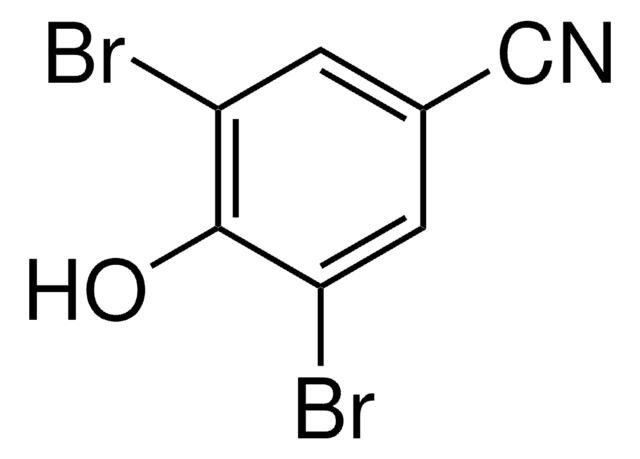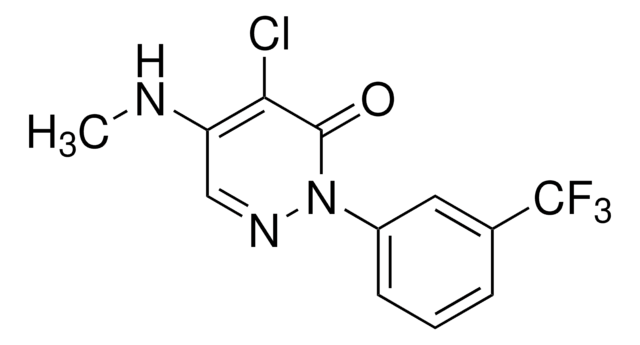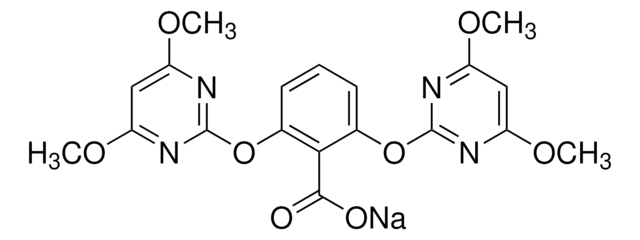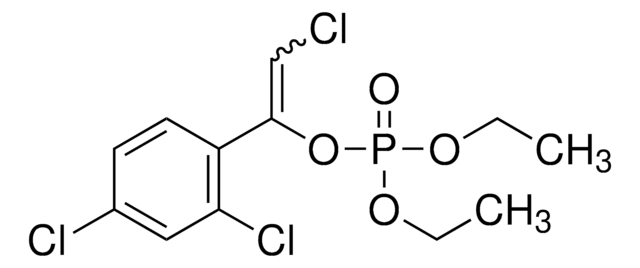All Photos(1)
About This Item
Empirical Formula (Hill Notation):
C16H14N2O2S
CAS Number:
Molecular Weight:
298.36
Beilstein:
1143987
EC Number:
MDL number:
UNSPSC Code:
41116107
PubChem Substance ID:
NACRES:
NA.24
Recommended Products
grade
analytical standard
Quality Level
product line
PESTANAL®
shelf life
limited shelf life, expiry date on the label
technique(s)
HPLC: suitable
gas chromatography (GC): suitable
application(s)
agriculture
environmental
format
neat
SMILES string
CN(C(=O)COc1nc2ccccc2s1)c3ccccc3
InChI
1S/C16H14N2O2S/c1-18(12-7-3-2-4-8-12)15(19)11-20-16-17-13-9-5-6-10-14(13)21-16/h2-10H,11H2,1H3
InChI key
XIGAUIHYSDTJHW-UHFFFAOYSA-N
Looking for similar products? Visit Product Comparison Guide
General description
Mefenacet is widely used as a herbicide to suppress broadleaf and grass weeds in rice paddies, golf courses, landscape garden, park and other types of fields.
Application
Mefenacet may be used as an analytical reference standard for the determination of the analyte in fruits and vegetables, river water and soil by various chromatography techniques.
Refer to the product′s Certificate of Analysis for more information on a suitable instrument technique. Contact Technical Service for further support.
Recommended products
Find a digital Reference Material for this product available on our online platform ChemisTwin® for NMR. You can use this digital equivalent on ChemisTwin® for your sample identity confirmation and compound quantification (with digital external standard). An NMR spectrum of this substance can be viewed and an online comparison against your sample can be performed with a few mouseclicks. Learn more here and start your free trial.
Legal Information
PESTANAL is a registered trademark of Merck KGaA, Darmstadt, Germany
Hazard Statements
Precautionary Statements
Hazard Classifications
Aquatic Chronic 2
Storage Class Code
11 - Combustible Solids
WGK
WGK 2
Flash Point(F)
>212.0 °F
Flash Point(C)
> 100 °C
Personal Protective Equipment
dust mask type N95 (US), Eyeshields, Gloves
Choose from one of the most recent versions:
Already Own This Product?
Find documentation for the products that you have recently purchased in the Document Library.
Multiresidue analysis of pesticides in vegetables and fruits using two-layered column with graphitized carbon and water absorbent polymer.
Obana H, et al.
Analyst, 126(9), 1529-1534 (2001)
Determination of mefenacet by capillary electrophoresis with electrochemiluminescence detection.
Liu S, et al.
Talanta, 69(1), 154 159-154 159 (2006)
Md Abul Kashem et al.
Biosensors, 9(4) (2019-11-16)
A microalgae (Pseudokirchneriella subcapitata) biosensor chip for pesticide sensing has been developed by attaching the immobilized microalgae biofilm pon the microarray dye spots (size 100 μm and pitch 200 μm). The dye spots (ruthenium complex) were printed upon SO3-modified glass
Suresh Kumar Kailasa et al.
Talanta, 205, 120087-120087 (2019-08-28)
A facile and novel nanosensor analytical strategy was developed for the colorimetric detection of pencycuron fungicide in rice, potato, cabbage, and water samples based on the pencycuron-induced aggregation of 6-aza-2-thiothymine-functionalized gold nanoparticles (ATT-AuNPs). The ATT-AuNPs exhibited good stability and were
Zhi-gang Yu et al.
Journal of chromatography. A, 1216(15), 3090-3097 (2009-02-19)
A procedure based on solid phase extraction (SPE) has been developed for the simultaneous pre-concentration of herbicide mefenacet (MN) and its three photolysis degradation products. Three metabolites studied were hydroxylbenzothiazole (HBT), N-methylaniline (N-MA) and 2-benzothiazoloxyacetic acid (2-BAA). A trimethylsilylation derivatization
Our team of scientists has experience in all areas of research including Life Science, Material Science, Chemical Synthesis, Chromatography, Analytical and many others.
Contact Technical Service








